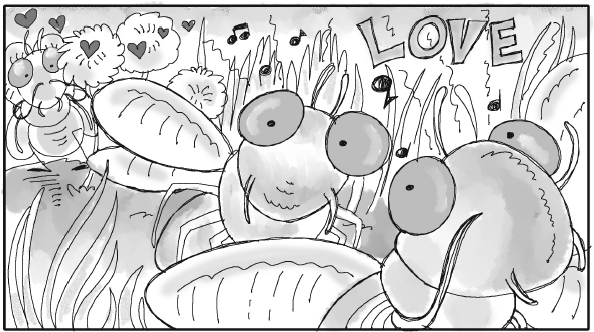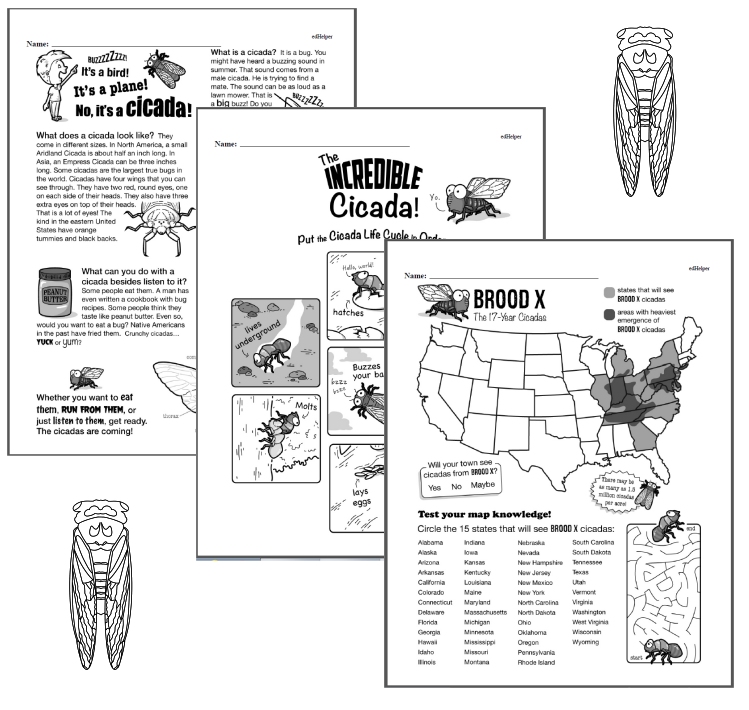Kids will start with a reading comprehension that is followed by writing and questions. Then add some fun puzzles and social studies pages, and these free workbooks will win over your students!

Free Workbooks for Learning about Cicadas [No Login Required]

Free Kindergarten Cicadas Workbook
Free 1st Grade Cicadas Workbook
Free 2nd Grade Cicadas Workbook
Free 3rd Grade Cicadas Workbook
Free 4th Grade Cicadas Workbook
Free 5th Grade Cicadas Workbook
Free 6th Grade Cicadas Workbook
Seventeen Years of Slumber
It's like the insect version of Rip Van Winkle. After seventeen years of slumber, the periodic cicadas are back! States from Georgia to New York and most of the Midwest could be in for a rude awakening this month thanks to the regular summer cicadas and the periodical cicadas reawakening simultaneously. This batch, known as Brood X or Great Eastern Brood cicadas, will likely be one of the largest in history, as billions are expected to soon emerge in 15 out of 50 states plus Washington, D.C. So, what exactly are these crazy creatures, and how can you take advantage of their invasion and use it as a once-in-seventeen year learning experience for your students and children?
What are They?
Cicadas are large flying insects. The tell-tale buzzing that easily alerts you to their presence is the male cicada's way of attracting a female mate. Think of it as his one-man-band attempt to attract a partner. While periodic cicadas live underground for 13-17 years surviving on sap and juices from the roots of trees, once above ground, they near the end of their lifecycle. Most will only live for a few weeks. So besides the loud BBQ crowds in the neighborhood, by Labor Day, your walk in the park should be much quieter (and less bug-infested!)
Why do They Emerge?
Cicadas emerge to reproduce. A female cicada will lay an average of 600 eggs. She cuts V-shaped slits in twigs and deposits upwards of 20 eggs in each spot. After 6-10 weeks, the eggs hatch, and the nymphs quickly burrow underground, where they will remain for the next 13-17 years.
The Good:
While cicadas may be seen as unwelcome visitors, they are beneficial in many ways. The holes the nymphs create as they burrow and tunnel underground naturally aerate the soil, providing more nutrients and oxygen for tree roots. Additionally, as females lay eggs in tree branches, the damage can help prune trees. Cicadas are also a great food source for predators like birds, snakes, and spiders. Finally, once they have completed their life cycle and begin to decompose, they provide rich, needed nutrients for plants.
The Bad:
While the cicadas will emerge in droves (likely to try and ensure the survival of at least part of the pack since many will be eaten by predators), there's no need to fear their resurfacing. Unlike a plague of historical proportions or something out of a horror movie, cicadas will not fly in swarms and devour everything in their path. They will not destroy crops, harm animals, or infest our food supply. They may make patio dining a little challenging and certainly noisy, but for the most part, these summer sun-seekers are like college students. After a long season tucked away in the dark, they just want to enjoy the last few weeks of life looking for a mate in the sunshine. Can you blame them? They will be a nuisance, but they aren't dangerous.
How to Make the Most of Their Appearance:
Nature is providing us the perfect opportunity to explore the great outdoors this summer with the cicada's reappearance. Earplugs may be required, but here are a few ideas and activities you can try with your learners to make the most of this year's visitors:
Name that Stage: Have your students use this free printable of the life cycle of a cicada to identify each stage. See if they can guess the stage of the real cicadas they are seeing (and hearing!) outside. Can they correctly identify them?
Cicada Bingo: Just in time for the Brood X appearance, cicadamania.com has created cicada mania bingo cards. With squares filled with observations like "saw a dog or human eat a cicada", "made some cicada-themed art" and "held a cicada or let one crawl on you", your students will be encouraged to engage with nature.
Neon Nuisance: Make the most of this noisy nuisance and turn their leftover shells into art! Students can collect the split shells left behind when cicadas emerge with wings and leave to mate. Using neon nail polish or other paint with a fine brush, students can decorate the leftover shells and have a memento of the summer guests.
Watch and Write: Few of us will witness the moment when the cicadas make their way up from underground. This video from BBC Earth, however, will let you and your students have a front-row seat as the cicadas make their grand entrance. Pair that with cicada-themed activity books and engage your students with multiple modalities as they learn more about the famous flying insects.
Cicada-Themed Activity Books:
Free Kindergarten Cicadas Workbook
Free 1st Grade Cicadas Workbook
Free 2nd Grade Cicadas Workbook
Free 3rd Grade Cicadas Workbook
Free 4th Grade Cicadas Workbook
Free 5th Grade Cicadas Workbook
Free 6th Grade Cicadas Workbook
Doodle or Draw: After observing the cicadas outdoors, invite your students to make a silent version of the summer visitor. These step-by-step drawing directions will support your students in drawing a cicada. They can use pencils and markers or play with other mediums such as watercolors or crayons.
Cicada Cookies: Why not bake a batch of sugar cookies and decorate them to look like cicadas in different stages of their lifecycle? If you really want to do some big-time bug baking, you could use a cicada cookie recipe that uses crickets! Chirps Cricket Powder, one of the main ingredients in the cookie recipe, is a high protein powder filled with, you guessed it, crickets!
The reappearance of the Brood X cicadas will surely make for a memorable summer. Take advantage of this once-in-seventeen-year occurrence to ignite a passion for science and inspire awe at the wonder of nature. While much is known about cicadas, there is still plenty of mystery surrounding these burrowing insects. Perhaps we will know more about them by the time they reappear in 2038! And perhaps one of your current students will be the future expert to teach the world all about them.
Trending

Weekly Lesson Plan Power-Ups

Daily Math Practice

Math Homework for Generation Alpha

Freebies for Busy Teachers

Wordle Worksheets

Mental Math Task Cards

Elementary School Children Don't Get Enough Math Practice at Home

10 Math Worksheets That Work for Teachers (Free Printables)

Do Math Worksheets Really Work? What We Found May Surprise You.

Best Teaching Ideas

Math Worksheets
Free Math Worksheets - No Login
Kindergarten Jumbo Math Worksheets PackFirst Grade Jumbo Math Worksheets Pack
Second Grade Jumbo Math Worksheets Pack
Third Grade Jumbo Math Worksheets Pack
Fourth Grade Jumbo Math Worksheets Pack
Fifth Grade Jumbo Math Worksheets Pack
Sixth Grade Jumbo Math Worksheets Pack
Middle School Jumbo Math Worksheets Pack
